Shep Hyken's Blog, page 60
July 27, 2022
Exit Interviews and Staying Interviews
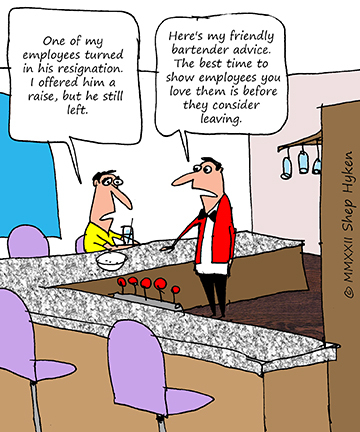 One of my favorite sayings is, “What’s happening inside an organization is felt on the outside by the customer.” You can’t expect to consistently deliver a great customer experience if you aren’t creating a great employee experience. So, let’s examine the employee experience to find out what makes employees happy with their jobs.
One of my favorite sayings is, “What’s happening inside an organization is felt on the outside by the customer.” You can’t expect to consistently deliver a great customer experience if you aren’t creating a great employee experience. So, let’s examine the employee experience to find out what makes employees happy with their jobs.
Some companies conduct exit interviews for employees who have chosen to move on. We can learn quite a bit from these interviews, including problems and shortcomings. Sometimes it’s not that our company isn’t a good place to work, but someone has offered an even better place to work. That may be as important, if not more so, than knowing what drives your employees away.
Yet consider what makes employees stay. Have you ever conducted a staying interview? On the surface, the staying interview would appear to be the opposite of an exit interview, but it’s not. There are reasons employees stay with you, and you need to know what they are. Here are some to consider:
The boss is great. One of the top reasons employees leave is because they can’t stand their boss. Employees enjoy their coworkers. Like the boss, employees may be on their way out if they don’t like the people they work with. The culture aligns with the employee’s values – and everyone seems to be in alignment with the culture. This one could be at the top of the list. The company stands for something (a cause, charity, etc.) that is important to the employee. This is especially important with Gen-Z and Millennials. Employees get to work on tasks and projects that they enjoy. It’s not that all work needs to be fun, but it should have truly enjoyable and fulfilling moments. Employees may have unique abilities or talents that the company takes advantage of. People love it when they get to do what they’re good at. Employees feel challenged. There is a sense of pride when someone meets their goals. There is an opportunity for growth and advancement. Employees want to know there is a future at the company. Continual training keeps employees interested and helps build new skills. Employees are empowered and given responsibility. If you hire good people and train them well, let them do their job! Employees are proud of their company and its accomplishments. Employees feel valued. This goes to two areas. First, they feel valued by the people they work with, both the boss and coworkers. And of course, there’s proper compensation and benefits.That’s a dozen reasons I came up with in just a few minutes. Think about how many more you could uncover if you sat down with your team and had a focused meeting on this subject.
Be purposeful about what makes your company a great place to work. You’ll notice more customer engagement, employees will evangelize your brand, and even more importantly, they will stay!
Shep Hyken is a customer service expert, keynote speaker, and New York Times, bestselling business author. For information on The Customer Focus customer service training programs, go to www.thecustomerfocus.com. Follow on Twitter: @Hyken
customer service training programs, go to www.thecustomerfocus.com. Follow on Twitter: @Hyken
The post Exit Interviews and Staying Interviews appeared first on Shep Hyken.
July 26, 2022
Amazing Business Radio: Deon Nicholas
 Human-Centered AI
Human-Centered AIUsing AI to Enable and Empower Customer Service Agents
Shep Hyken interviews Deon Nicholas, CEO and Co-Founder of Forethought, a company that builds human-centered AI to transform the customer service experience. He shares how companies can use AI and technology to help customer support agents and customers find the best resolution.





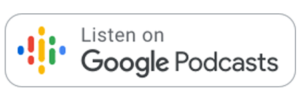
 Top Takeaways:A lot of people think that AI is all about deflecting customers away from support agents. However, AI is about solving the customer’s problem by providing a self-service option, interacting with a bot, or getting that customer to a human.Human-centered AI is not just about resolving the issue. It is also about being able to recognize when the best thing to do is to get out of the way. Certain problems require human judgment and empathy. Human-centered AI is all about connecting and getting the customer to an agent in the right channel at the right time.If you can take historical data, such as questions customers have asked in the past and issues they have called about, then you can build a knowledge base around this data that agents can use to help customers.Customers want speed and an easy experience, but that doesn’t matter if they don’t get the answer to their question or their problem resolved.Deon Nicholas also talks about the three elements that organizations must have to deliver the ultimate customer experience. Tune in!Quotes:
Top Takeaways:A lot of people think that AI is all about deflecting customers away from support agents. However, AI is about solving the customer’s problem by providing a self-service option, interacting with a bot, or getting that customer to a human.Human-centered AI is not just about resolving the issue. It is also about being able to recognize when the best thing to do is to get out of the way. Certain problems require human judgment and empathy. Human-centered AI is all about connecting and getting the customer to an agent in the right channel at the right time.If you can take historical data, such as questions customers have asked in the past and issues they have called about, then you can build a knowledge base around this data that agents can use to help customers.Customers want speed and an easy experience, but that doesn’t matter if they don’t get the answer to their question or their problem resolved.Deon Nicholas also talks about the three elements that organizations must have to deliver the ultimate customer experience. Tune in!Quotes:“The three most important factors in real estate are location, location, location. The three most important factors in business are people, people, people.”
“Never sacrifice ease and getting a correct resolution in the name of efficiency.”
“In amazing businesses, the most important thing to think about is our people. Everything that we have ever done in humanity has been about building technology by people, for people. Double down on your people, and you will see the dividends and the returns.”
About:Deon Nicholas is the CEO and Co-Founder of Forethought, the AI company whose mission is to transform customer experiences with human-centered AI. Before starting Forethought, Deon built products and infrastructure at Facebook, Palantir, Dropbox, and Pure Storage.
Shep Hyken is a customer service and experience expert, New York Times bestselling author, award-winning keynote speaker, and host of Amazing Business Radio.
This episode of Amazing Business Radio with Shep Hyken answers the following questions and more:
What is human-centered AI?Why is human-centered AI important?Will AI take over customer service?How is AI enhancing the customer service experience?How can AI enable and empower agents?The post Amazing Business Radio: Deon Nicholas appeared first on Shep Hyken.
July 25, 2022
5 Top Customer Service Articles of the Week 7-25-2022
Each week I read many customer service and customer experience articles from various resources. Here are my top five picks from last week. I have added my comment about each article and would like to hear what you think too.
3 Ways Companies Make Work Purposeful by Michael Mankins, Eric Garton, and Dan Schwartz(Harvard Business Review) In the aftermath of Covid-19, many companies have boosted pay, and offered greater flexibility in order to recruit and retain the best people. At some, senior leaders have attempted to inspire employees by emphasizing a corporate purpose or mission, in the same hope.
My Comment: Many companies are finding it difficult to create a great customer experience due to getting and keeping good employees. Our first article of this week’s Top Five roundup address that very issue. Straight from HBR, we learn three ways to make our employees work more purposeful. Purposeful work can lead to employee fulfillment, which leads to long-term employment.
11 Ways to Increase Brand Loyalty Through Better Email Marketing by Young Entrepreneur Council(AllBusiness) Considering all the emails consumers receive on a daily basis, email marketing can be a tricky form of marketing to undertake. However, when done right, it can be an effective communication tool to gain new clients and customers. This also means that, with a little strategic planning and creative thinking, businesses can leverage their email marketing to increase brand loyalty and keep customers.
My Comment: Email marketing is typical marketing until you focus on the customer and not just making a sale. Here are eleven ways to use email to go beyond typical marketing and sales and to engage and create a better customer experience.
CX + EX: The Formula for a Customer-Obsessed Culture by Nathan Eddy(CMSWire) Brands seeking to build a customer-obsessed culture need to focus on more than just customers. They also need to think about employees.
A good employee experience (EX) supports and enhances customer experience (CX) in many ways.
My Comment: If you want a good customer experience (CX), the company needs to create a good employee experience (EX). As Chris Pennington, chief customer officer at SugarCRM points out in the article, “Customer and employee experiences are not two separate functions in the business; they are heavily intertwined.” The author draws on the expertise of Pennington and two others to make the case for a strong EX.
6 Considerations for a Meaningful Customer Service Policy by Kate Spirgen(Garden Center Magazine) The right customer service philosophy can not only help you and your employees provide better service, it can help you find meaning in your work, said Liz Lark-Riley, managing director of Rockledge Gardens, at her Cultivate’22 session, “The Secret to Keeping Promises: Customer Service 101 for Garden Retailers.”
My Comment: What customer service lessons can you learn from a garden retailer? Quite a bit. The Garden Center magazine recaps Liz Lark-Riley’s session at the garden industry’s meeting, Cultivate ’22. She shares the six main tenets that support her “mantra” (my word, not hers), which is “Customer service is really about making and keeping promises.”
Changing Perception: Simple Ways to Improve Your Customers’ Waiting Experience by Jamie Johnson(business.com) If you’ve ever worked in customer service, you already know that long wait times frustrate most customers. Doctors’ offices, marketing agencies, salons, automotive garages, restaurants, law firms and many other businesses must manage how much time their clients spend in reception areas.
My Comment: For those who have a business where customers wait (doctors’ offices, law firms, restaurants, auto repair centers, salons, etc.), this is a must-read article. Nobody likes to wait. The author shares four ideas on what to do, as well as some thoughts on what to not do, that impacts the customer’s experience with you.
[image error]Shep Hyken is a customer service expert, professional speaker, and New York Times bestselling business author. Go to The Customer Focus to learn more about our customer service training programs. Follow on Twitter: @Hyken
to learn more about our customer service training programs. Follow on Twitter: @Hyken
The post 5 Top Customer Service Articles of the Week 7-25-2022 appeared first on Shep Hyken.
July 22, 2022
Guest Post: How the Status Page Improves the Customer Experience
This week we feature an article by Andrian Valeanu, Founder & Editor-in-chief of Design Modo, a company that helps brands create websites and email newsletters so they can focus on running their business. He shares how a website’s status page can help keep customers informed and improve their overall experience with a brand.
Did you know that the average manufacturer experiences more than 15 hours of downtime per week, whereas small websites and services are out of the game from five hours to almost several days in a year? According to Forbes, downtime, which is an unavoidable event since uncontrollable factors like human errors, imperfections of hardware, or natural disasters cause it, has become an actual problem for digital businesses around the World.
The deal is that customers are unwilling to waste their precious time on web platforms that are down because their standards and expectations are high. However, they are ready to wait if the website provides an excellent customer experience and keeps them in the loop during the outage. And there is a time-proven solution for that – the status page.
Let us look at the status page concept and its hidden potential for securing clients’ base and improving customer experience during downtime.
What Is a Status Page?A status page is a tool to communicate incidents that happened in the backend of the web platform. At the core, it is just a regular HTML/CSS web page. However, it is synced with monitoring and tracking snippets and tools. Therefore, its content is dynamic and displays the current state of the system every single minute.
Status pages fall into two general categories:
A public status page. It is open to everyone, designed for website visitors, and easily accessible through a direct link on the homepage. A private status page. It is created specifically for developers and support teams. It is used to communicate information among the company’s departments and is usually hidden from prying eyes.Both these pages are crucial elements of the incident management process. They deliver necessary data about the current system’s health and scheduled maintenance to the visitors and company’s departments in time. Plus, they include additional tools like a subscription form or direct chat with the support team to eliminate all possible concerns and immediately address apparent issues.
How the Status Page Improve the Customer Experience?Status pages have a huge potential to improve customer experience. They are dark horses of all successful companies, not for nothing. Let’s consider ways of how they do that.
Keep Customers InformedAs banal as it may sound, keeping customers informed is a time-tested way to improve customer experience.
With a well-thought-out approach, the deal is that a public status page can be turned into a treasure trove of information. It may include every aspect of the system’s current operational state, from the health status of individual parts of the infrastructure to the history of incidents to active chat with the support team.
While for readers of blogs or online magazines, such quality does not seem so special, when it comes to customers whose businesses largely depend on the reliability of third-party services like payment systems, booking APIs, server and hosting providers, this comes of enormous importance.
By staying informed all the time, those customers can single out the problem and ipso facto avoid conundrums with their respective clients and visitors. On top of that, they may take some actions to keep clients in the loop by providing an apologetic discount or offer right in time.
Therefore, providing total situational awareness considers a feature of a one-of-a-kind customer experience. If you can bring it to life, you will certainly improve your overall customer experience.
Keep Customers NotifiedLet us be honest; even if our business depends on third-party services, we are too busy to check them out every minute to ensure everything is fine. We appreciate being notified when something has happened and not wasting our precious time in vain.
In fact, being notified even about issues with our beloved digital magazines and blogs make us feel great. To be more precise, according to Maslow’s hierarchy of human needs, it makes us feel important and satisfies our inner esteem needs of prestige.
All successful companies know about these users’ expectations and needs. Therefore, they notify them why the system failed and when it happened and keep them posted during the incident management process.
Being notified in time is an indicator of excellent customer experience. Therefore, if you still do not have a status page with a subscription form to keep users updated on resolution progress or inform them when something has happened, you should undoubtedly add one since it will considerably improve the customer experience.
Help Customers Plan Interactions with System EffectivelyOne of the features of the status page is that it communicates information about the scheduled maintenance that happens quite often in third-party systems like servers and hosting providers. This helps users plan their time correctly, maximize interactions with the system, and avoid wasting their precious time on idling and procrastination.
Make the Support Team Work ProductivelyThe most significant advantage of creating public status pages is that it answers the burning issue, calms down the digital crowd, and eases frustration. This reduces the number of customer support queries and customer complaints that distract the team’s attention from resolving the problem.
The absence of a continuous flow of requests allows the company’s departments to do their job quickly and more efficiently, regaining the system and bringing the web platform back on track in a short time.
Plus, when the support team is not distracted by already-known issues, they can deal with other requests and provide high-quality support across various verticals, thereby improving the overall customer experience with the platform.
Provide Control Over SituationWith status pages paired with tracking software, dev teams get complete control of the situation. They choose what information to display, how to communicate incidents, what users reach through alternative distribution channels like email, Twitter, or even TikTok, and how to win time without killing the mood.
With complete control over the situation, the dev team gets an excellent opportunity to avoid other incidents caused by the outage and provide alternative solutions for users just in time, thereby reinforcing the overall customer experience.
Offer Invaluable Information for Improving SystemLinked to monitoring and tracking devices, the private status page provides the dev team with all crucial technical data to start the incident management process as early as possible and sort out the issue before it escalates.
Moreover, the team might learn more about incident frequency, develop a reusable solution that helps minimize drastic outcomes of outages, and, most importantly, secure a helpful and friendly customer service experience that is the number one strategy of all successful companies.
Make Users Feel IncludedLast but not least. We have been chiefly discussing the technical side of improving customer experience; however, what about the psychological aspect? As it turned out, a clever status page can also satisfy the psychological needs of customers by making them feel included. And people want that since it is our natural desire to be a part of the process even though there is nothing we can do.
Providing a status page with all sorts of helpful information (such as the system’s current health, details about the incident, and most importantly, resolution progress), the company satisfies this psychological need and triggers a long-lasting positive emotional response. Plus, the company proves its care and commitment to the clients. All this takes customer experience to an entirely new level.
ConclusionStatus pages are powerful instruments in the incident management process. They provide the support team with all crucial information to address the issue in time, and most importantly, they improve the customer experience from various perspectives, including technical and psychological aspects.
Andrian Valeanu is a web designer and indie maker. He is the Founder & Editor-in-chief of Design Modo. His interests include information technologies, web design, and email marketing.
 For more articles from Shep Hyken and his guest contributors go to customerserviceblog.com.
For more articles from Shep Hyken and his guest contributors go to customerserviceblog.com.
Read Shep’s latest Forbes article: Customer Service The Marriott Way
The post Guest Post: How the Status Page Improves the Customer Experience appeared first on Shep Hyken.
July 20, 2022
Different is Better Than Better
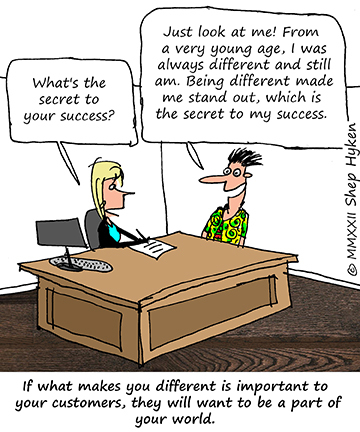 I’m going to break just a bit from my typical customer service/customer experience ideas and share another lesson: Different is better than better.
I’m going to break just a bit from my typical customer service/customer experience ideas and share another lesson: Different is better than better.
This was my big takeaway as I listened to supermodel, talk show host, producer, writer, actress, and entrepreneur Tyra Banks share her life story at CCW (Contact Center Week), the industry’s largest conference and trade show of its kind. Early in her successful modeling career, someone advised her to try to fit in. In other words, don’t make waves, don’t stand out, don’t take risks, don’t … I could go on and on with the “don’ts.” Somehow, she knew, at least for her, this was not good advice.
I loved when Tyra said, “Different is better than better.” Yes, she wanted to be better than everyone else, but in the modeling world, she recognized that being different might be even more important. And, as I thought about this, I realized it’s true for almost every business.
I wrote about this once before, almost four years ago, in an article titled Be Different. The gist of that article was about doing something different than your competition. Something that would make you stand out. Something that you could be known for and would differentiate you from your competition. For example, Volvo is known for safety, and Jimmy John’s Gourmet Sandwiches is known for freaky fast delivery.
While Tyra’s comments were about standing out, it is actually more than that. She didn’t just look for something that would make her different. She took a risk on that difference. As a model, she tried something crazy. At a fashion show, all the other models just walked the runway like everyone else. It was that runway strut with minimal facial expressions, allowing the clothes to take center stage. Tyra was modeling a designer’s cape, and when it was her turn, she decided to take a risk and be different. She knew the clothes were the stars of the show, but she also wanted to add some personality to the moment. She went out on stage doing all kinds of crazy, flamboyant gyrations with the cape. It was a risk. The public opinion on her decision was touted as brilliant. It helped take her career to a new level – not because she was different, but because she tried something different.
So, it’s not that you are different. It’s what you’re willing to try that’s different. It might give you a competitive advantage, and more importantly, it will set you apart from others. Tyra Banks was still a supermodel after her “flamboyant moment.” But something changed. She had even more recognition. That’s a significant benefit to being different, not just better. And if what makes you different is important to your customers, they will want to be a part of your world.
Shep Hyken is a customer service expert, keynote speaker, and New York Times, bestselling business author. For information on The Customer Focus customer service training programs, go to www.thecustomerfocus.com. Follow on Twitter: @Hyken
customer service training programs, go to www.thecustomerfocus.com. Follow on Twitter: @Hyken
The post Different is Better Than Better appeared first on Shep Hyken.
July 19, 2022
Amazing Business Radio: Megan Neale
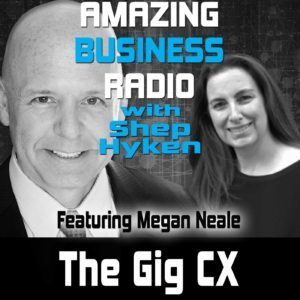 The Gig CX
The Gig CXEmploying Brand Advocates to Improve Customer Experience
Shep Hyken interviews Megan Neale, Co-founder and COO of Limitless, a Gig CX platform that empowers people to earn money by providing brilliant customer service. She shares how brands can leverage brand advocacy and the knowledge of actual product users (customers) to improve customer experience.






 Top Takeaways:Customers who love using your products can be great resources to answer questions, resolve issues, and share experiences. They have the knowledge and passion for the brand that can be turned into a skill to help other customers.Some customers answer questions on forums for free just because they enjoy doing it. However, relying solely on forums is not scalable or reliable for delivering consistent customer service.Almost every company could benefit from tapping into their passionate customers and bringing them into the heart of their business by helping other customers.How does the GigCX work? Megan Neale outlines how her platform, Limitless, works with companies to use a strong community to help brands meet rising customer expectations and demands.Companies identify customers who demonstrate brand loyalty, knowledge, and skills to help other customers. They are invited to join the platform and be a part of the GigCX program.Once in the program, they must prove their skills, knowledge, and brand passion. They are chosen because of their experience using the products and then, they are provided with the proper training around the processes a brand will need them to follow.When they are ready, they receive inquiries and can choose the questions that are right for them. They get paid for every ticket that they are able to resolve successfully.Quotes:
Top Takeaways:Customers who love using your products can be great resources to answer questions, resolve issues, and share experiences. They have the knowledge and passion for the brand that can be turned into a skill to help other customers.Some customers answer questions on forums for free just because they enjoy doing it. However, relying solely on forums is not scalable or reliable for delivering consistent customer service.Almost every company could benefit from tapping into their passionate customers and bringing them into the heart of their business by helping other customers.How does the GigCX work? Megan Neale outlines how her platform, Limitless, works with companies to use a strong community to help brands meet rising customer expectations and demands.Companies identify customers who demonstrate brand loyalty, knowledge, and skills to help other customers. They are invited to join the platform and be a part of the GigCX program.Once in the program, they must prove their skills, knowledge, and brand passion. They are chosen because of their experience using the products and then, they are provided with the proper training around the processes a brand will need them to follow.When they are ready, they receive inquiries and can choose the questions that are right for them. They get paid for every ticket that they are able to resolve successfully.Quotes:“Customers want to get help and seek advice from people like them.”
“Customer support provides such a critical role to the organization’s success. However, they are sometimes undervalued instead of rewarded for the important work they do.”
“The volume of customer support requests coming to organizations is increasing. Utilizing customers to help other customers does not displace traditional contact center workers. It is a way to support the volume of engagement in a cost-effective way.”
“Tapping into your most loyal consumers to enhance customer experience builds trust and creates a connection of empathy.”
About:Megan Neale is Co-founder and COO of Limitless, an AI-powered Gig CX platform. Her passion for “customer & client first” and her constant drive for innovation led her to co-found Limitless in 2016.
Shep Hyken is a customer service and experience expert, New York Times bestselling author, award-winning keynote speaker, and host of Amazing Business Radio.
This episode of Amazing Business Radio with Shep Hyken answers the following questions and more:
What is GigCX?What is brand advocacy?Why are brand advocates important?How can companies leverage brand advocates?Will GigCX replace traditional customer service?The post Amazing Business Radio: Megan Neale appeared first on Shep Hyken.
July 18, 2022
5 Top Customer Service Articles of the Week 7-18-2022
Each week I read many customer service and customer experience articles from various resources. Here are my top five picks from last week. I have added my comment about each article and would like to hear what you think too.
5 Things Brands Need to Know About the Gen Z Customer Experience (and Employee Experience) by Radi Hindawi and Jim Katzman(Retail TouchPoints) If we were to sum up what brands need to know about Gen Z customer experiences preferences (and employee experience preferences) in a few words, it would go something like this: they’re different. Revolutionary even. This may seem like an oversimplification, but when you think about it, Gen Z grew up in a world that is more connected than ever, has more access than ever, and accomplishes everything faster than ever. It makes sense, then, that their standards for customer and employee experiences would be higher than ever too.
My Comment: Gen Z is an important group of consumers (and employees). They have different expectations than older generations, and brands that want to sell or employ them must understand those differences. This article hits some of the highlights with the help of the 2022 Experience Trends report.
3 Questions to Assess Your Customer Experience Efforts by Jeannie Walters(CMSWire) One of the biggest challenges leaders face is evaluating the success of their customer experience efforts. There are believers and non-believers when it comes to customer experience as a successful business driver. Those non-believers? They lack one important bit of information: the connection between CX and business value and outcomes.
My Comment: Jeannie Walters, one of the customer service and experience recognized thought leaders, poses three questions that could make for some very interesting conversations. I won’t give them away in this short description, but these questions could be what you need to get focused on in your CX efforts. I’ll add one more. What words do you want your customers to use when they describe you? Of course, the experience you provide must be worthy of that kind of praise.
10 Aspirational Customer Experience Quotes from the Pros by Cassandra Vincent(CSAT.AI) You want to be the best in your industry. Listen to the advice of some of the best. Here are some aspirational customer experience quotes from the pros on practices to aim your business for the stars.
My Comment: I’m a big fan of motivational quotes in the CX and customer service spaces. Here’s a list of ten quotes from some well known names and popular brands. (Thank you, CSAT.ai, for including my quote!) Number three is my favorite: “To deliver a high-touch experience, employees must be treated the way they’re expected to treat customers: exceptionally.” – Kristi Runyan.
Cheap Beer and Recessions: How to Survive and Thrive With Exceptional Customer Experience by Justin Racine(CMSWire) With recessions, brands will be challenged to compete against low-cost competitors and customer spending pullbacks.
My Comment: Want to smile? Just read the title of this article. The author shares his experience as a cash-strapped college student trying to have the “full college experience” on a tight budget. Many companies are impacted by the recession and have been forced to tighten their budgets. The result is they struggle to deliver the customer experience that they are used to providing. Here are a few ideas to help you through the struggle.
10 Stats Showing How B2B CX Has Changed by Blake Morgan(Forbes) Customer experience was finally starting to catch up in the B2B world to match technology-driven and personalized B2C experiences. But then the pandemic turned everything on its head. But change isn’t always bad. Although brands were left reeling from these rapid and drastic changes, B2B companies that adapt to the transforming buyer journey can create a competitive advantage by connecting with buyers and offering experiences that match new demands.
My Comment: My friend and fellow customer experience expert, Blake Morgan, shares ten stats that B2B businesses should pay attention to. I geek out over this type of information. Here’s a good one (number 3) from her article: 100% of buyers want self-service options for at least a part of the buying process. For those B2B companies out there that think a corporate purchasing agent isn’t interested in self-service, think again!
BONUSAdapting Software With Your Workforce is Vital: Reconcile High-tech With High-touch in Awesome Customer Service by Daniel Burrus(BBN Times) While machines, artificially intelligent applications, and other types of customer service software will only accelerate in its ability to better serve customers on all levels, it will disrupt the way things are currently done. This disruptive wave transforms the roles of those in customer service positions at organizations of all kinds, but with an Anticipatory mindset, you as a professional or business executive can get in front of these disruptions.
My Comment: My friend Daniel Burris, one of the top innovation experts in the world, wrote an article posing the question, “Can machines replace human customer service reps and processes if they find a way to make them empathetic?” A very intriguing question, indeed! This is part two of the article and includes several examples I shared with Daniel in an interview we did earlier this year.
[image error]Shep Hyken is a customer service expert, professional speaker, and New York Times bestselling business author. Go to The Customer Focus to learn more about our customer service training programs. Follow on Twitter: @Hyken
to learn more about our customer service training programs. Follow on Twitter: @Hyken
The post 5 Top Customer Service Articles of the Week 7-18-2022 appeared first on Shep Hyken.
July 15, 2022
Guest Post: How to Create Massive Customer Surplus through Memorable Onboarding & Obsessive Service
This week we feature an article by Michael Becker, founder of Scaling Sciences, a growth agency for coaches. He shares how organizations can gain loyal customers by providing an experience that exceeds expectations.
The stakes have effectively been raised, and they’ll continue to go up for product brands, service providers, and client-based companies alike.
In 2022, and moving forward, simple fulfillment isn’t enough. Not hardly.
Amazon does more than deliver packages — they “WOW.” And as a result, we’ve become addicted to the on-demand whatever-you-want immediacy, the ridiculously easy swipe-and-receive culture, plus the reassurance that comes with no-hassle returns. That’s worth $13 per month for my Prime membership, and I don’t ever stop to question whether it is. My service is so good that I stay and I pay.
We’ve entered a new era of service where businesses that are serious about scaling and retaining their customers — especially small businesses using continuity models (e.g., payment plans or monthly subscriptions) — have no choice but to over-deliver at every turn (or risk losing customers to others who do).
10x Treatment for New ClientsI’m in the coaching space so let me dive into what a 10x customer onboarding process may feel like. I’ll explain how you might choose to go above and beyond at each step.
Step 1: A prospective client schedules a call with you. You read through their intake form, and instead of shrugging it off and passively waiting until the call, you dig through their website or social media and pull out 2-3 golden nuggets about what they’re doing that you can help improve upon or just complement. Within 30 minutes of the scheduled call, you make them a quick self-recorded video thanking them and sharing your excitement. You send it over along with a link to a private recording of your inner circle VIP call plus an “ultimate guide” PDF they might find useful.
Step 2: They show up for the call, and even though the meeting goes well, they mention they’re diligent and will see it through before they’re ready to get going. No problem. You offer them a free 14-day trial to your program and send them a hard copy of a great book that you mentioned on the call.
Step 3: Due to your generosity, personalized advisory, and ability to identify and solve their problems for free up-front, they decide to sign up with you five days later. You immediately record another welcome video, this time screen sharing directions once insider plus expert hacks to help them get off and running. You email them the welcome video and a link to get scheduled with you for an in-depth call where you’ll outline a specific game plan with them. You give them your personal cell so they can text you anytime with any issues, big or small.
Step 4: You assign your best client success manager on their account and ensure they’re scheduled for your monthly training workshops as a non-negotiable. You see what other freebies you can share to add additional value. You make a calendar note for yourself to proactively send them biweekly text message voice note check-ins.
Step 5: You send a feedback survey plus a gift card after four weeks in the program to gauge where they’re at and see how it’s going. Meanwhile, the client is amazed at the depth and quality of your training due to your effort in putting together the most all-inclusive program on the market in your niche.
Step 6: The client shoots you a text message with a quick question. You record an in-depth response leading to a 1-hour impromptu phone call where you can further connect on a 1:1 level and forge a much deeper relationship.
Step 7: You plan a trip to visit the client in person for a two-day workshop to ensure success and implementation. You’ve prepared a 10-page booklet specific to them and their opportunities and a new, never-before-seen training video you wanted them to see before anyone else for feedback.
This type of client engagement is one example of the almost obsessive customer centricity I’m talking about. At the end of the day, the client in the above scenario is going to feel incredibly “taken care of.” They’re going to feel like you did everything in your power (and then some) to propel them toward lasting results – that you want their success more than they do.
ConclusionGreat customer experience today is all about 1:1 accountability and interaction, sweetening the pot at every touch point, and going well beyond anything that client has felt before.
From a numbers standpoint, I believe that the real mark of successful businesses (or those poised to explode) is how effectively they can overdeliver while maintaining or even increasing margins and incurring very little added expenses.
Delivering much more value than customers asked for is the only way to create the kind of coherence that leads to unfettered loyalty.
We want clients to become raving fans so they feel as if they need us as badly as they need their sleep. Why? Because at the moment in which that level of satisfaction has been established, prices become mostly irrelevant, and you’re now playing an entirely different game based on devotion, emotion, and reciprocity… and that’s the long-term game where you win, the client wins, and you can truly create impact in the world.
Michael Becker is the founder of the growth agency for coaches, Abundance Accelerators. He is a recognized thought leader in business automation and internet marketing.
 For more articles from Shep Hyken and his guest contributors go to customerserviceblog.com.
For more articles from Shep Hyken and his guest contributors go to customerserviceblog.com.
Read Shep’s latest Forbes article: Three Lessons To Create A Better Customer Experience
The post Guest Post: How to Create Massive Customer Surplus through Memorable Onboarding & Obsessive Service appeared first on Shep Hyken.
July 13, 2022
Give Them Help Before They Yelp
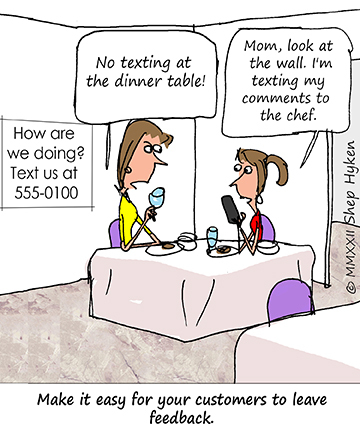 Online reviews can work in two ways. For a company that provides a great customer experience, reviews can add credibility and bring in more business. But for companies that don’t provide an acceptable experience, online reviews can become the bane of their existence. And the world gets to watch how they handle the problems.
Online reviews can work in two ways. For a company that provides a great customer experience, reviews can add credibility and bring in more business. But for companies that don’t provide an acceptable experience, online reviews can become the bane of their existence. And the world gets to watch how they handle the problems.
But what if you don’t have the type of business that gets Yelp or Google reviews? It doesn’t matter what type of business or industry you’re in. You are not immune from bad reviews. There is a forum for every industry where customers talk. It may not be as public as Yelp, but it’s the place where your customers share their experiences with their colleagues.
I had an opportunity to interview Adam Alfia of Realtime Feedback for an episode of Amazing Business Radio. Realtime Feedback is exactly what it sounds like. Alfia and his team created a solution for customers to leave feedback at the moment it’s needed. The result is that the company can fix the problem before the customer has the chance to go public with a negative experience and possibly create a PR nightmare. Alfia shared a great line: “Give them help before they Yelp.”
When Realtime Feedback was starting up, that was its mantra. Alfia had been working in the restaurant industry, and whenever he saw a bad review, he took it personally. His solution was to have a manager visit every table and get feedback that they could use, if necessary, to fix any problems immediately.
Yet even with that effort, customers would choose to be non-confrontational and ignore the opportunity to complain or mention if something wasn’t right. Some people have anxiety about face-to-face confrontations. So, Alfia and his brother would ponder, “How do we get customers to engage us and tell us the truth?”
It wasn’t long before they created a solution, which was to provide a QR code customers could scan with their phones to connect to a platform where they could share any problems or complaints. Then, someone takes care of the issue before the customer leaves the restaurant. The result eliminated the problem of getting their customers to share feedback. It turned out that customers were more willing to share feedback digitally than in person.
Whatever your method for gathering customer feedback, here are four lessons:
It’s important to get feedback. It’s a gift. Appreciate that your customers are willing to share their thoughts with you. It’s important to make it easy for customers to leave feedback in the way they are most comfortable in doing so. Once you get feedback, react – and do it quickly. If you wait, customers may go elsewhere to share their feedback. That might be to a social channel, which leads us to No. 4 … Heed the advice of Adam Alfia: Give them help before they Yelp!
Shep Hyken is a customer service expert, keynote speaker, and New York Times, bestselling business author. For information on The Customer Focus customer service training programs, go to www.thecustomerfocus.com. Follow on Twitter: @Hyken
customer service training programs, go to www.thecustomerfocus.com. Follow on Twitter: @Hyken
The post Give Them Help Before They Yelp appeared first on Shep Hyken.
July 12, 2022
Amazing Business Radio: Julius Robinson
 Building Confidence with Your Customers
Building Confidence with Your CustomersEmpowering Your Team to Deliver a Great Customer Experience
Shep Hyken interviews Julius Robinson, Chief Sales & Marketing Officer at Marriott International. He shares what organizations can learn about customer service from the hospitality industry and how to equip employees to meet and exceed customer expectations.






 Top Takeaways:The fundamentals of customer service start with individual customer interactions. First, we must learn how to deal with all the different inquiries at the start of the customer’s journey. Then, try to meet them where they are so we can anticipate their needs and find opportunities to enrich their experience.Technology has allowed customers to take control of their experience. If done right, technology can help provide the great experience they expect from your brand.Julius Robinson also shares two things organizations can do to create a great customer experience.Ask the right questions. Customers don’t always verbalize what their needs and wants are. Make time to find out what they expect from you.Empower your employees to deliver a great experience. Find out what the customers’ end goals are. An example from the hospitality industry is if it is a family that hasn’t travelled since the pandemic started and is concerned about health, employees need to have the information and tools to give the customers confidence in a safe travel experience.Marriott International believes that if you take care of your associates, they will take care of the customer. They call it the TakeCare It is a culture that is all about listening, having empathy, responding with clarity, and delivering on the customer’s expectations.Quotes:
Top Takeaways:The fundamentals of customer service start with individual customer interactions. First, we must learn how to deal with all the different inquiries at the start of the customer’s journey. Then, try to meet them where they are so we can anticipate their needs and find opportunities to enrich their experience.Technology has allowed customers to take control of their experience. If done right, technology can help provide the great experience they expect from your brand.Julius Robinson also shares two things organizations can do to create a great customer experience.Ask the right questions. Customers don’t always verbalize what their needs and wants are. Make time to find out what they expect from you.Empower your employees to deliver a great experience. Find out what the customers’ end goals are. An example from the hospitality industry is if it is a family that hasn’t travelled since the pandemic started and is concerned about health, employees need to have the information and tools to give the customers confidence in a safe travel experience.Marriott International believes that if you take care of your associates, they will take care of the customer. They call it the TakeCare It is a culture that is all about listening, having empathy, responding with clarity, and delivering on the customer’s expectations.Quotes:“Enable your teams to overcome problems authentically. Empower them with broad guidelines and proper training, and they will do great things for the customers.”
“In many cases, customers give a higher satisfaction rating if a problem they have encountered is resolved properly than customers who did not experience any problem at all.”
“Being customer-obsessed means meeting the customer at their needs and creating special moments in every opportunity.”
About:Julius Robinson is the Chief Sales & Marketing Officer at Marriott International. He leads the disciplines of Sales, Distribution, Field Marketing, Franchise Sales, Marketing & Revenue Management Support, and Public Relations and Crisis Communications for Marriott International.
Shep Hyken is a customer service and experience expert, New York Times bestselling author, award-winning keynote speaker, and host of Amazing Business Radio.
This episode of Amazing Business Radio with Shep Hyken answers the following questions and more:
What makes a great customer experience? How do you build customer confidence?How has customer service evolved over the past two years?What are the emerging trends in customer service?What does it mean to be customer-obsessed?The post Amazing Business Radio: Julius Robinson appeared first on Shep Hyken.



